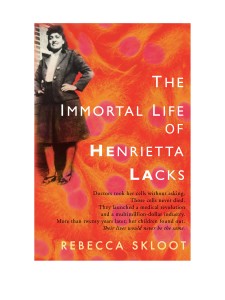 “HENRIETTA LACKS,” Professor Defler wrote in large letters on the blackboard of a community college class. Rebecca Skloot, sixteen-years old at the time, sat in biology class captivated, listening to the story of the HeLa cell line for the first time. Her professor told the class that Henrietta died in 1951 from a vicious case of cervical cancer, but that before she died, a surgeon took samples of her tumor. These samples would become the first human cells ever to grow successfully in culture. Her cells, he continued, went on to be used for the research and drug development crucial to finding treatments for cancer, herpes, leukemia, influenza, hemophilia, and Parkinson’s disease. In a nutshell, the “HeLa” cell line was one of the most important medical advances of the last one hundred years. At the end of his story, Defler added, “She was a black woman.”
“HENRIETTA LACKS,” Professor Defler wrote in large letters on the blackboard of a community college class. Rebecca Skloot, sixteen-years old at the time, sat in biology class captivated, listening to the story of the HeLa cell line for the first time. Her professor told the class that Henrietta died in 1951 from a vicious case of cervical cancer, but that before she died, a surgeon took samples of her tumor. These samples would become the first human cells ever to grow successfully in culture. Her cells, he continued, went on to be used for the research and drug development crucial to finding treatments for cancer, herpes, leukemia, influenza, hemophilia, and Parkinson’s disease. In a nutshell, the “HeLa” cell line was one of the most important medical advances of the last one hundred years. At the end of his story, Defler added, “She was a black woman.”
Throughout college, as she encountered HeLa cells working in various biology classes, Skloot remained fascinated by the woman who had unwittingly been the most important contributor to medicine in the past century. While attending graduate school to become a writer, Skloot became fixated on someday telling Henrietta’s story. The Immortal Life of Henrietta Lacks is the product of a decade of research into the HeLa cell line, its namesake, and the Lacks family.
In 1951, Henrietta Lacks entered the colored ward of Johns Hopkins hospital, the only hospital in the Baltimore area that would treat African Americans at the time. While she was getting a suspected tumor inspected, doctors took a small sample of the tumor for research purposes without her knowledge or consent, a common practice at the time. Seemingly miraculously, her tumor cells, unlike those taken from others, grew rapidly when plated in culture.
Within months, large quantities of “HeLa” cells were grown and sent to other researchers around the country. Henrietta Lacks died of cervical cancer. The woman was no more, but her cells lived on. Since the 1950’s, the use of HeLa cells in research has led to some of the greatest advances in modern science and medicine. Millions have benefitted from the work done with HeLa cells, and countless lives have been saved. Thousands of jobs have been created, and pharmaceutical companies make millions of dollars each year from drugs developed through research using HeLa cells.
As her cells became famous for their incredible scientific potential, the memory of the woman behind them was largely forgotten. As one of Henrietta’s cousins remarked, “Her cells done lived longer than her memory.” In her book, Skloot recreates the woman who was Henrietta Lacks, and delves deep into the painful stories of her family The tale that unfolds addresses such weighty topics as medical ethics, race, science, spirituality, and poverty tactfully and thoughtfully. She brings to light how the very cells that brought so much good to the world nearly destroyed a family, and in doing so, calls to attention aspects of medical ethics that have yet to be addressed.
When I had the chance to speak with her during her recent visit to Yale University, Skloot explained, “If you have an ability to write knowledgeably about science, you can actually do really great things and inspire change.” This conviction is clear in Skloot’s telling of The Immortal Life of Henrietta Lacks. Overall, I would highly recommend this book. It is an enjoyable read that poignantly calls attention to the deeper ethical implications of research using human tissues. The material is very accessible, and it is rare that a nonfiction, science book reads like a novel. Those who have worked with HeLa cells may never look at their research the same way again. As Skloot reminds us, “There’s a human being behind every sample that you use.”
